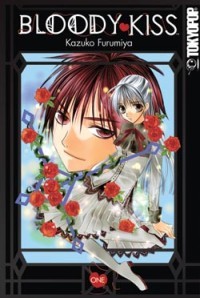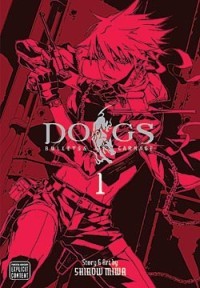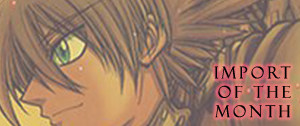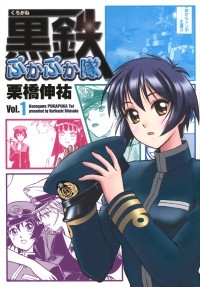RIGHT TURN ONLY!!
Dogs: Barking and Chewing
by Carlo Santos,

I don't know what the deal is between me and dogs. Whenever I run into someone walking their dog at my apartment complex, the critter invariably starts trying to follow as if I were some target to be chased. I think I've only run into a couple of dogs that were well-trained enough to not go into a leaping frenzy every time I walk past them.
The neighbors' cats, who just sit around watching you, are much more manageable.
BLOODY KISS

Vol. 1
(by Kazuko Furumiya, Tokyopop, $10.99)
FROM THE BACK COVER:
"When Kiyo inherits her grandmother's house, she gets a lot more than she bargained for. You see, also living in the home are two hot vampires—Kuroboshi and his servant, Alshu! Then things go from weird to bloody crazy when Kuroboshi decides to make Kiyo his 'bride'—his only source of blood!"
EVIDENCE FOR:
Kiyo Katsuragi is actually kind of cute! For starters, she can fend for herself, which is more than can be said about certain other vampire-story heroines. As might be expected, she does most of her fending against Kuroboshi, who is charming in his own way with his ill-timed amorous advances and devil-may-care attitude. The result is a love-hate relationship with more spunk and energy than the average vampire romance; it's simply a lot more fun when the couple is genuinely at odds with each other and trading pointed one-liners rather than spouting out goopy professions of love. Even when Kuroboshi does get what he wants—a taste of Kiyo's sweet, sweet bodily fluids—there's usually some kind of slapstick payoff right afterward, because biting into girls' necks is so cliché these days that making fun of it is the only way to go. Straightforward panel layouts help to keep the story moving at a decent clip, and the elegant sense of character design (especially at the school dance) guarantees some attractive visuals.
EVIDENCE AGAINST:
Vampire stories. Really now. Well, at least this series doesn't get the automatic full-letter-grade deduction for having "vampire" in the title, but it still gets a knock for using the word "blood." It also gets another knock for giving in way too easily to the fangirl fantasy of vampiric neck-biting, as proven by the sudden outburst of sparkles and detailed background work every time Kuroboshi does his business. Look, if you're doing a vampire comedy, you have to stand your ground against really dumb clichés! Throwing it in once per chapter out of obligation is just mindless formulaic fanservice, even if it does get made fun of afterwards. Meanwhile, the effectiveness of the supporting cast hovers somewhere between useless and infuriating, as evidenced by Alshu's lame habit of trying to spirit Kiyo away from Kuroboshi. (What is the whole point of this? Love triangle? Manly rivalry? Whatever it is, it's not working.) This whole attempt at vampire romantic comedy just comes out a mess, as does the artwork, which despite the good readability still falls victim to poor toning choices, badly staged angles, and faces and dialogue bubbles being shoved in wherever they fit. How anemic.
FINAL VERDICT:
This one gets points for trying. The main characters are generally appealing and the chemistry works, but the overall execution falls flat and lands this volume at a C-.
DOGS: BULLETS AND CARNAGE

Vol. 1
(by Shirow Miwa, Viz Media, $12.99)
FROM THE BACK COVER:
"Badou's in trouble again. He's found some of the 'Lost Children,' rare genetic experiments left from the past—but so has the mafia. It's up to Heine to bail him out, but the Stray Dog has his own problems now that the enigmatic Giovanni is back on the scene. Meanwhile, Naoto comes to the Underground searching for the killer who wields the same strange black sword as hers. And so their paths begin to converge in the dark and dangerous heart of the city..."
EVIDENCE FOR:
What is it that makes Dogs' style of gunplay stand out so much from other similarly-themed series? Maybe it's the sharp black-and-white contrasts, or the dizzying and dynamic view angles, or the way Shirow Miwa strips away the backgrounds to make sure that we focus entirely on the combatants. Or maybe—and here comes the real answer—it's the way all these elements combine to form pure urban-action eye candy. There's a ballet-like elegance in the way the characters face off, with sure-handed lines and split-second poses turning every scene into a framable piece of art. It's impressive enough when Heine blows up the joint in his one-versus-one-hundred takedown of various mafia goons, but the duel with Giovanni takes things a whole new level of artistry and scope; nothing brings out the best in a fighter like facing an evenly matched opponent. Let's not forget Naoto's role either as she swoops around with her longsword—even when standing still, she oozes coolness in a way that few other characters are capable of. The fight rages on, and every moment of it is blood-soaked bliss.
EVIDENCE AGAINST:
Now here's a series would make a perfect Hollywood adaptation. You know why? Because it's built on a preposterous, paper-thin plot, makes use of all-style-no-substance characters, and relies on special effects and explosions to distract the audience from its glaring flaws. Volume 0 may have had the problem of various disconnected characters, but at least those characters each had a story; this one gives up on storytelling and turns into a mindless bloodbath after about the first five pages or so. The only time anyone tries to advance the plot, it seems, is when someone stops and says, "Hey, whatever happened to so-and-so?" "Oh, they're probably out busy right now." Yeah, busy filling up page after page with gunfire and corpses. A well-orchestrated fight scene is always impressive, but when that's the only thing going on for a hundred-odd pages, the impact is quickly lost. Even cheesy genre elements like the church and the priest and the winged girl become pointless afterthoughts when everything is just scene after scene of people shooting at each other. Wake me up when there's a real story.
FINAL VERDICT:
Ah, so beautiful ... and so mindless. But as far as action series go, where visual titillation is the whole point anyway, this one still manages a B-.
GESTALT

Vol. 2
(by Yun Kouga, Viz Media, $8.99)
FROM THE BACK COVER:
"In the legendary past the gods battled for supremacy and cast out the demon god whose name cannot be spoken. Banished to Earth, the demon found refuge on the mysterious and dangerous island known only as 'G.'
Olivier, priest of the Vasariah Order, is not his usual self, and Ouri summons an incubus to draw out the seed of Olivier's black mood. Later, the 'game' between Ouri and her siblings becomes clearer as they all make their way toward G and the great treasure that awaits the winner. Ouri, however, is playing with a few interesting handicaps—but that won't slow down their progress toward G, even if Ouri and Olivier's enemies aren't about to give them a break!
EVIDENCE FOR:
Does Yun Kouga's ability to dream up new characters and new worlds know no bounds? With the first volume of Gestalt already having gone through a roller-coaster ride of medieval, magical combat, this next installment proves that there are even more surprises to be discovered along the way to the land of G. Little snippets of backstory reveal new secrets about Ouri's mysterious past, and even secondary characters like the sorceress Takara and fortune-teller Shazan turn out to have personal histories worth looking into. In fact, Shazan even gets an entire sub-story arc to himself in the middle chapters of this volume, and it's here that Kouga gets to bust out her artistic talents in full force; hand-to-hand combat, monster summoning, and new characters with fancy costumes demand the highest form of visual creativity, and Kouga is happy to supply it. Even in more mundane scenes of traveling through town and routine conversation, the sweeping linework and free-flowing layouts give the series a liveliness that is rarely seen in other fantasy works.
EVIDENCE AGAINST:
So ... are the still actually trying to travel to the land of G, or what? This story seems to be losing track of itself with each succeeding chapter, resulting in a freeform fantasy roadtrip that has almost nothing to do with its original premise. Rather than actually questing toward a specific place, Father Olivier and friends seem content to shuffle from town to town, having random encounters that result in visually arresting scenes of battle. Heck, Father Olivier doesn't even seem to be the main character anymore—and this is only the second volume! The speed at which new characters arrive and new story points are introduced also ends up backfiring; instead of helping to build up the plot, it just makes things more confusing, especially where Ouri is concerned. (Genderbending? Siblings? Where is this all coming from?) A number of abrupt scene transitions and sudden changes of direction also guarantee that the storytelling will never reach its full potential—it's hard to get caught up in a fantasy adventure when events seem to happen at random and characters wander off with unexplained motivations.
FINAL VERDICT:
I keep wanting to like this series for how pretty it is, but the haphazard storyline is holding it back. Another round of hocus-pocus and occasional sword-swinging gets a C this time.
KITCHEN PRINCESS

Vol. 10
(by Miyuki Kobayashi and Natsumi Ando, Del Rey, $10.99)
FROM THE BACK COVER:
"Najika heads to Paris for a major cooking competition, while things with Daichi fall apart and personal tragedy strikes again. Will Seiya pick up the pieces? And will Najika stay true to Daichi?"
EVIDENCE FOR:
NOOOO don't tell me it's the last volume! But it is, and ultimately, this emotional rollercoaster ends in the best way it possibly could. There are so many heartwarming, feel-good moments in these final chapters that there's barely enough space to mention them all: a reconciliation between father and son, a courageous declaration of love, and of course ... the revelation of a truth that completes the circle between Najika's past and present. While some may have made a lucky guess about which guy Najika would end up with, few could have predicted the journey that she would take in getting there. Even now, a couple of well-timed twists and resolutions still give each chapter a suspenseful pull all the way to the end. Natsumi Ando's illustration and layout skills also keep the story flow going—proof that it's possible to work with the highly ornamental shoujo style and still show clearly what's going on. You can tell that there are some scenes in here she's been waiting the entire series to draw—and they just glow with the incredible warmth and emotion of a love story well told.
EVIDENCE AGAINST:
To the very end, Kobayashi keeps throwing in random coincidences and acts of God that just happen to make everything work out. Really, Granny Hagio, what a perfect time for your medical conditions to act up! And once those same crises cease to be important to the plot, they're usually resolved with a little bit of vague hand-waving. Even the conclusion to the "Who is Najika's Flan Prince?" mystery lacks any cleverness to it; the answer seems to arrive simply because they ran out of options and the series was already ending anyway. The emotional turnarounds also have a tendency to happen out of the blue; Daichi's feelings seem to change out of sheer convenience rather than any deep personal struggle, and the situation between Najika and Seiya has softened into weakly-smiling mush even though they were romantically in conflict with each other not too long ago. Although Najika launches into this deep, nostalgic monologue about the power of friendship and love, she's only there because all the obstacles have been conveniently swept out of her way by an author's invisible hand.
FINAL VERDICT:
To be honest, the real finale with all the dramatic turnarounds arrived in Volume 9. But as a heartwarming wrap-up of loose ends, this one still pulls a respectable B+.
ÔOKU

Vol. 1
(by Fumi Yoshinaga, Viz Media, $12.99)
FROM THE BACK COVER:
"In Edo Period Japan, a strange new disease called the Redface Pox has begun to prey on the country's men. Within eighty years of the first outbreak, the male population has fallen by seventy-five percent. Women have taken on all the roles traditionally granted to men, even that of the shogun. The men, precious providers of life, are carefully protected. And the most beautiful of the men are sent to serve in the shogun's Inner Chamber..."
EVIDENCE FOR:
It is a testament to Fumi Yoshinaga's formidable talent that she can come up with a series that is so different from all her other works, yet carries all the signature traits of her style. Where else are you going to find a tale of alternate-history, female-dominated Japan and still have it become a complete bishounen parade? Basically, Yoshinaga imagines a gender-reversed imperial court full of male concubines, and spits out this masterpiece that works on multiple levels—emotional, cultural, political. The tale of Mizuno, which takes up most of this volume, is epic in every sense of the word: starting from humble beginnings, the story gradually builds up the characters and plotlines within the Inner Chambers until finally soaring to a heart-wrenching climax and poignant ending. Along the way, societal peculiarities are explored as well (the encounter with a Dutch merchant is all sorts of hilarious) and the last chapter suggests that even more dramatic twists are in store. Of course, none of this would be possible without Yoshinaga's effortless artistry, with sinuous lines, detailed surroundings, and highly attractive, expressive characters. Once you get lost in this world, you may never want to leave.
EVIDENCE AGAINST:
Oh man, lots and lots of hot guys in historical Japan! That's got to be an instant recipe for success, right? Well, Yoshinaga is so deliberate about laying out the conditions of this alternate Edo Period that the early chapters often descend into dull history lectures instead of being gripping tales of political and imperial intrigue. And when it does try to bring in elements of imperial intrigue, they sound more like cheesy BL fantasies instead of deep and fascinating explorations of a gender-role-reversed society. (Old manga-ka habits die hard, it seems.) The dullness of the historical material even extends into the art sometimes, where we get page after page of traditional palace interiors and guys in robes and not much else. Come on, spice it up a little! A little historical inaccuracy never hurt anyone! Finally, opinions are probably going to be divided on the translation, which goes above and beyond with archaic dialogue patterns that reflect the speech of the times but are a pain to read. Especially when everyone talks a lot.
FINAL VERDICT:
It may seem dry at first, and the style of dialogue takes some time getting used to, but once the story gets rolling it's absolutely A- material.

KUROGANE PUKAPUKA TAI

Vol. 1
(by Shinsuke Kurihashi, Ikaros, ¥952)
FROM THE BACK COVER:
"The secret weapon of the Japanese navy is ... a commerce raider packed with girls!
At the outset of the Pacific war, in order for the Japanese fleet to win against the allied U.S. and British forces and further the military achievements of the Empire, they bring the battle far to the west ... the military power of the Unebi is sent into the Indian Ocean.
Their mission is to ambush the enemy's commerce vessels and obstruct the transport of resources.
What destiny awaits the Unebi, a lone warship taking on countless dangerous missions with its feminine crew...!?"
EVIDENCE FOR:
Hetalia can go straight to hell. If you want a real WWII spoof with hilarious characters, great gag situations, and an explosive dose of military action, then go no further than this bishoujo-packin', yuri-smackin' send-up of naval warfare. Even the setting itself is surprisingly original—when was the last time you read a wartime story about British trade routes along the Indian Ocean?—and the artwork, far from being a weak point, is actually strong enough to match up to Shinsuke Kurihashi's storytelling ambitions. Historical-military wonks will get a thrill out of the stat sheets and artistic detail that go into the seagoing vessels and weaponry, while fans who are just in it for guns and explosions will be impressed by the sheer variety: not only is there ship-to-ship combat, but also aerial missions, emergency rescue, and even a madcap swordfight. Why a swordfight, you ask? Because the other subplot in this series involves sapphic love polygons between the Unebi's crew and other lovely officers from England and Germany. Does it get any more awesome than that?
EVIDENCE AGAINST:
Sometimes, throwing a crazy idea out there isn't good enough—and while there's something to be said about the surefire equation of girls + guns + ships + WWII + everyone being in love with everyone else, the sum of these parts doesn't quite add up. The characters may be entertaining, but rely too much on easily assigned stereotypes, like the clueless one, the refined one, the boy-crazy one, and the underage-looking one (of course they had to get her in there somewhere). Even the idea of the German U-Boat commander being a scent fetishist is kind of a head-scratcher. The overall plot, too, lacks structure and direction: Kurihashi tries to string chapters together every now and then to build up epic battles, but it's clear that he doesn't have much of an idea where things are headed apart from having the Unebi plow across the seas and get into shootouts with enemy forces. And for all the artistic polish on each page, there are still some slip-ups like the blatant use of photo-referencing and screentone overload. This war comedy isn't a complete victory just yet.
FINAL VERDICT:
Truth be told, plotlessness and character stereotypes are the kind of things I can overlook when I just want silly, offbeat fun—and this is a series that provides that in spades.

What is the logic that drives manga licensors to ride aboard the "by the creator of" bandwagon? It may make sense from a sales perspective, but as Amanda O. explains below, sometimes there's just manga that never should have been licensed! Keep sending in your submissions for this one, folks!
MILLENNIUM SNOW

Vol. 1-2
(by Bisco Hatori, Viz Media, $8.99)
This shojo story begins with a simple scene of a girl (named Chiyuki) looking up to the top of a building to see a boy falling (on purpose) from the roof. Granted, he doesn't land gracefully and she goes to see what's wrong. The boy is introduced as Toya, a vampire who can't stand the smell of blood and claims that Chiyuki reeks of it. Chiyuki was actually hospitalized for a heart condition since she was small and has always lived in the hospital. Through twists of fate, Chiyuki begins to unlock Toya's hate/dislike of humans by learning the real reason he doesn't want to be around them is because he doesn't want to have the pain of losing them.
To me, this sounds like a great story, and coming from Bisco Hatori (famed creator of Ouran High School Host Club), I couldn't wait to read it. After reading volume 2, I realized there where no other volumes, not even in Japanese. I searched everywhere for more volumes or at least information if Hatori was going to finish it. I found in one Ouran volume in her notes that she wants to finish it but doesn't have any plans at the moment. It makes me curious though, with the world she's created with Ouran (a world that doesn't have real time), how will she ever complete it so she can work on other projects such as Millennium Snow?
And since I can do this, I'm going to add on this tidbit since it's not really a spoiler for the series since it happens in the second volume, but Millennium Snow seems like an earlier version of Twilight. However it's made right. Chiyuki is the average human, Toya's the vampire and then we have Satsuki (who comes in later) as the werewolf, thus completing the love triangle. Anyone else but me see the resemblance here? (And yes, I have read Twilight and know that Jacob isn't really a werewolf but you get my point, right?) It drove me insane the first time I read Twilight. I instantly thought of Millennium Snow. (I read MS before Twilight...)
But anyway, this is a great manga but other than to sell it to people who recognize Bisco Hatori's name and don't realize it doesn't even finish, I don't see the point of publishing it.
Is there a hidden gem of manga you'd like to reveal to the world? Is there a piece of garbage that deserves to be bashed in public? Or is there a title that didn't get a fair grade here, and you want to set the record straight?
Now's YOUR chance to be the reviewer! Write a review of about 300-400 words (a little more or less is fine) and include:
- Your name
- Title of manga (and volume no., if applicable)
- Author/Artist
- Publisher
- Briefly describe the story, then explain why this manga is great, terrible, or in between. Be objective, but also be entertaining.
Then send it in to rtoreaders (at) gmail (dot) com (plain text format preferred). One review will be selected out of all the submissions and will be published in the next column. All types of manga and manga-inspired comickry are accepted, from past and present, from Japan and beyond—what matters is that it's the Reader's Choice! NOTE: Submissions may be edited for formatting and grammar.
discuss this in the forum (17 posts) |